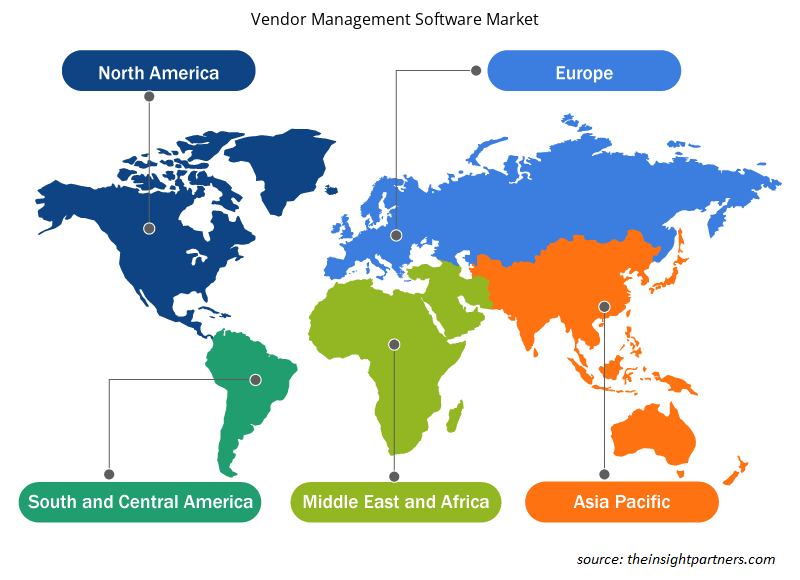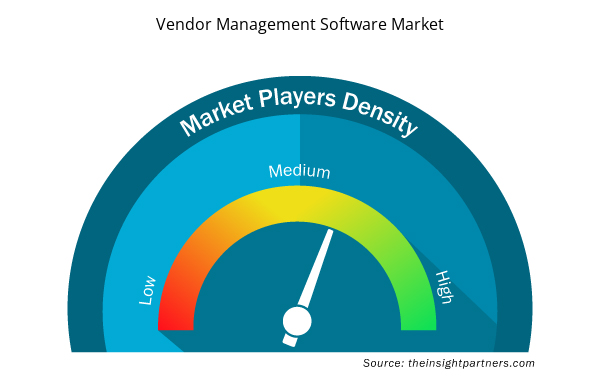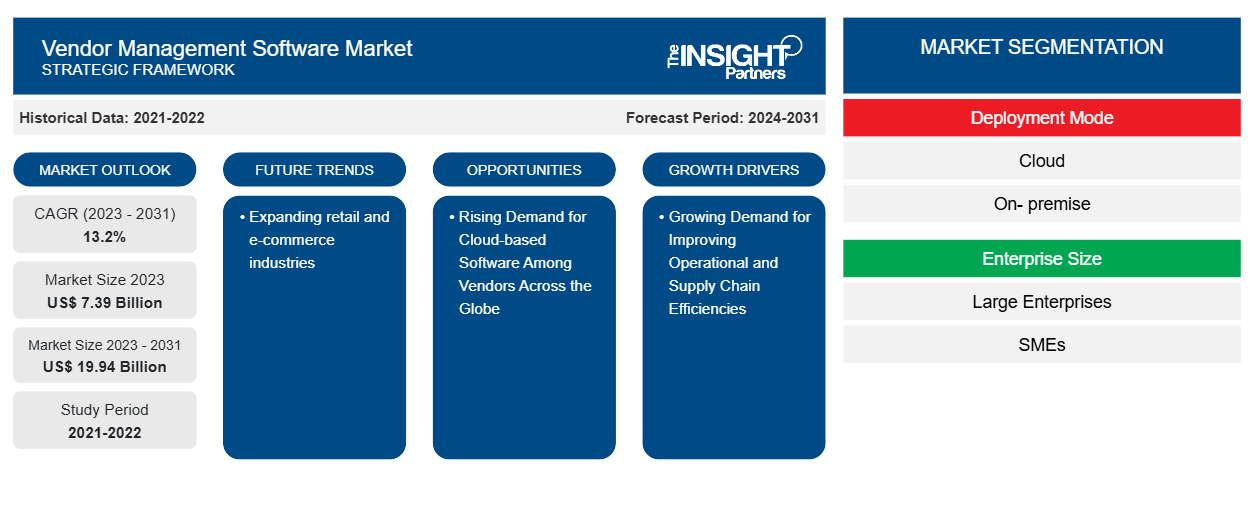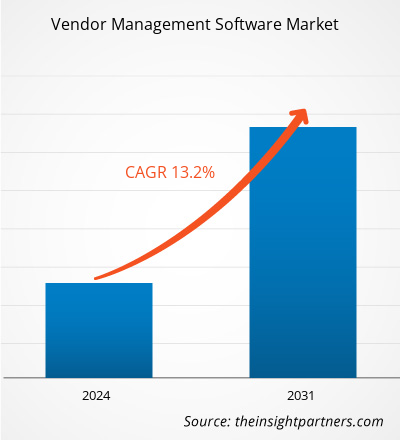ベンダー管理ソフトウェアの市場規模は、2023 年の 73 億 9,000 万米ドルから 2031 年には 199 億 4,000 万米ドルに達すると予測されています。市場は 2023 年から 2031 年にかけて 13.2% のCAGRを記録すると予想されています。小売業と電子商取引業界の拡大は、ベンダー管理ソフトウェア市場の主要なトレンドであり続けると思われます。
ベンダー管理ソフトウェア市場分析
ベンダー管理ソフトウェア市場は、運用およびサプライ チェーンの効率性向上に対する需要の高まりと、クラウド導入による中小企業の発展を促進する政府の重要な取り組みにより、急速に成長しています。ベンダー間で技術的に高度でコスト効率の高いソフトウェアに対する需要が高まっているため、市場は着実に拡大しています。さらに、世界中のベンダー間でクラウドベースのソフトウェアに対する需要が高まり、多くのベンダーとの関係を管理する複雑さが増していることから、市場の成長に有利な機会が生まれています。
ベンダー管理ソフトウェア市場の概要
ベンダー管理は、日常業務に必要な商品やサービスのサプライヤーとの関係を構築し、育むことです。ベンダー管理ソフトウェアは、ベンダーがサプライ チェーンや流通ネットワークを適切に管理するために使用するソフトウェア アプリケーションです。企業によるリスクの軽減と迅速な意思決定の必要性が高まるにつれ、ベンダー管理ソフトウェア市場の成長機会が生まれています。
要件に合わせてレポートをカスタマイズする
このレポートの一部、国レベルの分析、Excelデータパックなど、あらゆるレポートを無料でカスタマイズできます。また、スタートアップや大学向けのお得なオファーや割引もご利用いただけます。
- このレポートの主要な市場動向を入手してください。この無料サンプルには、市場動向から見積もりや予測に至るまでのデータ分析が含まれます。
ベンダー管理ソフトウェア市場の推進要因と機会
業務とサプライチェーンの効率性向上に対する需要の高まりが市場を牽引
さまざまな企業でビジネス プロセスを最適化するためにハイテク ソフトウェアの採用が増えていることから、ベンダー管理システムの導入が進んでいます。組織は、低コストで効率性を高めるためにビジネス プロセスの自動化にますます注力しており、ビジネス プロセスを最適化するベンダー管理ソフトウェアの需要が高まっています。ベンダー管理ソフトウェアは、ベンダー関連の情報と組織運営を管理して、長期的な成長を効果的に達成するために使用されます。ベンダー管理ソフトウェアを導入することで、組織は適切な対策を講じて潜在的なベンダー リスクを軽減し、コストを規制し、ベンダーから価値を得て、長期的に優れたサービス提供を確保することができます。これにより、予測期間中に市場が成長すると予想されます。
世界中のベンダーの間でクラウドベースのソフトウェアに対する需要が高まっています - ベンダー管理ソフトウェア市場におけるチャンス
世界中のベンダーの間でクラウドベースのベンダー管理ソフトウェアに対する需要が高まっており、市場にチャンスが生まれています。クラウドベースのベンダー管理ソフトウェアは、スケーラビリティ、手頃な価格、アクセシビリティなど、ユーザーに大きなメリットを提供し、ベンダーに現在のシステムとの統合の柔軟性を提供し、地理的に分散したベンダーを管理し、変動する需要に対応するためのリソースの迅速な拡張を可能にします。さらに、クラウドベースのソフトウェアの採用を促進するための政府の有利な投資が、市場にチャンスを生み出しています。たとえば、米国国防総省は、2022会計年度に非機密ITに約386億ドルを投資しました。行政管理予算局(OMB)は、クラウドの使用を促進するために、政府機関にソフトウェアプログラムポートフォリオの近代化、段階的廃止、または統合を義務付けました。これにより、顧客の間でクラウドベースのソリューションに対する需要が高まります。したがって、予測期間中に市場にチャンスが生まれます。
ベンダー管理ソフトウェア市場レポートのセグメンテーション分析
ベンダー管理ソフトウェア市場分析の導出に貢献した主要なセグメントは、展開モード、企業規模、および業界垂直です。
- 展開モードに基づいて、ベンダー管理ソフトウェア市場はクラウドとオンプレミスに分かれています。クラウドセグメントは2023年に大きな市場シェアを占めました。
- 企業規模に基づいて、市場は大企業と中小企業に分かれています。大企業セグメントは2023年に大きな市場シェアを占めました。
- 業界別に見ると、ベンダー管理ソフトウェア市場は小売、製造、BFSI、ITおよび通信、その他に分類されます。小売セグメントは2023年に大きな市場シェアを占めました。
地域別ベンダー管理ソフトウェア市場シェア分析
ベンダー管理ソフトウェア市場レポートの地理的範囲は、主に北米、アジア太平洋、ヨーロッパ、中東およびアフリカ、南米/中南米の 5 つの地域に分かれています。
収益面では、流通チャネル全体の効果的かつ効率的な管理の必要性が高まっているため、北米市場が最大のベンダー管理ソフトウェア市場シェアを占めています。中小企業の発展に向けた政府の重要な取り組みと投資が、予測期間中に市場を牽引しています。たとえば、2022年8月、米国財務省は、州中小企業信用イニシアチブを通じて7億5,000万米ドルを投資することにより、4つの州の追加入札を許可しました。財務省は、中小企業の成長を促進するために、総額22億5,000万米ドルを超える資金承認を発表しました。しかし、中小企業が流通ネットワークを改善するための高度なソフトウェアとソリューションの採用を促進するための政府の取り組みが市場を後押ししています。
ベンダー管理ソフトウェア市場の地域別分析
予測期間を通じてベンダー管理ソフトウェア市場に影響を与える地域的な傾向と要因は、Insight Partners のアナリストによって徹底的に説明されています。このセクションでは、北米、ヨーロッパ、アジア太平洋、中東およびアフリカ、南米および中米にわたるベンダー管理ソフトウェア市場のセグメントと地理についても説明します。

- ベンダー管理ソフトウェア市場の地域別データを入手
ベンダー管理ソフトウェア市場レポートの範囲
| レポート属性 | 詳細 |
|---|---|
| 2023年の市場規模 | 73億9000万米ドル |
| 2031年までの市場規模 | 199.4億米ドル |
| 世界のCAGR(2023年~2031年) | 13.2% |
| 履歴データ | 2021-2022 |
| 予測期間 | 2024-2031 |
| 対象セグメント | 展開モード別
|
| 対象地域と国 | 北米
|
| 市場リーダーと主要企業プロフィール |
|
ベンダー管理ソフトウェア市場のプレーヤー密度: ビジネスダイナミクスへの影響を理解する
ベンダー管理ソフトウェア市場は、消費者の嗜好の変化、技術の進歩、製品の利点に対する認識の高まりなどの要因により、エンドユーザーの需要が高まり、急速に成長しています。需要が高まるにつれて、企業は提供内容を拡大し、消費者のニーズを満たすために革新し、新たなトレンドを活用し、市場の成長をさらに促進しています。
市場プレーヤー密度とは、特定の市場または業界内で活動している企業または会社の分布を指します。これは、特定の市場スペースに、その規模または総市場価値と比較して、どれだけの競合相手 (市場プレーヤー) が存在するかを示します。
ベンダー管理ソフトウェア市場で事業を展開している主要企業は次のとおりです。
- クーパソフトウェア株式会社
- ゲートキーパー(Cinergy Technology Limited)
- HICXソリューションズ株式会社
- IBMコーポレーション
- インテレックステクノロジーズ株式会社
- ロジックマネージャー株式会社
免責事項:上記の企業は、特定の順序でランク付けされていません。

- ベンダー管理ソフトウェア市場のトップキープレーヤーの概要を入手
ベンダー管理ソフトウェア市場のニュースと最近の動向
ベンダー管理ソフトウェア市場は、主要な企業出版物、協会データ、データベースを含む一次調査と二次調査後の定性的および定量的データを収集することによって評価されます。以下は、ベンダー管理ソフトウェアと戦略の市場における動向の一覧です。
- 2022 年 11 月、Cloud5 Communications, Inc は、契約交渉や日常管理から問題のエスカレーションと解決まで、プロジェクト関係のライフサイクル全体を管理するための新しいプロジェクト管理ソリューションを開始しました。Cloud5 の PMO は、すべてのベンダーとのやり取りの単一のリソースとして機能し、ベンダーとの強力な関係を構築することで、料金の改善、コストの削減、ホテルスタッフの負担の大幅な軽減につながります。(出典: Cloud5 Communications, Inc、プレスリリース、2022 年)
ベンダー管理ソフトウェア市場レポートの対象範囲と成果物
「ベンダー管理ソフトウェア市場の規模と予測(2021〜2031年)」レポートでは、以下の分野をカバーする市場の詳細な分析を提供しています。
- 対象範囲に含まれるすべての主要市場セグメントの世界、地域、国レベルでの市場規模と予測
- 市場の動向(推進要因、制約、主要な機会など)
- 今後の主な動向
- 詳細なPEST/ポーターの5つの力とSWOT分析
- 主要な市場動向、主要プレーヤー、規制、最近の市場動向を網羅した世界および地域の市場分析
- 市場集中、ヒートマップ分析、主要プレーヤー、最近の動向を網羅した業界の状況と競争分析
- 詳細な企業プロフィール
- 過去2年間の分析、基準年、CAGRによる予測(7年間)
- PEST分析とSWOT分析
- 市場規模価値/数量 - 世界、地域、国
- 業界と競争環境
- Excel データセット


- Data Annotation Tools Market
- Customer Care BPO Market
- Fill Finish Manufacturing Market
- Greens Powder Market
- Virtual Production Market
- Single-Use Negative Pressure Wound Therapy Devices Market
- Helicopters Market
- Educational Furniture Market
- Micro-Surgical Robot Market
- Medical and Research Grade Collagen Market

Report Coverage
Revenue forecast, Company Analysis, Industry landscape, Growth factors, and Trends

Segment Covered
This text is related
to segments covered.

Regional Scope
North America, Europe, Asia Pacific, Middle East & Africa, South & Central America

Country Scope
This text is related
to country scope.
よくある質問
The incremental growth expected to be recorded for the global vendor management software market during the forecast period is US$ 12.55 billion.
The global vendor management software market is expected to reach US$ 19.94 billion by 2031.
The key players holding majority shares in the global vendor management software market are Coupa Software Inc., HICX Solutions Ltd., IBM Corporation, Intelex Technologies Inc., and LogicManager, Inc.
Expanding retail and e-commerce industries to play a significant role in the global vendor management software market in the coming years.
The growing demand for improving operational and supply chain efficiencies and significant government initiatives to promote SME development with cloud adoption are the major factors that propel the global vendor management software market.
The global vendor management software market was estimated to be US$ 7.39 billion in 2023 and is expected to grow at a CAGR of 13.2% during the forecast period 2023 - 2031.
Trends and growth analysis reports related to Technology, Media and Telecommunications : READ MORE..
The Insight Partners performs research in 4 major stages: Data Collection & Secondary Research, Primary Research, Data Analysis and Data Triangulation & Final Review.
- Data Collection and Secondary Research:
As a market research and consulting firm operating from a decade, we have published and advised several client across the globe. First step for any study will start with an assessment of currently available data and insights from existing reports. Further, historical and current market information is collected from Investor Presentations, Annual Reports, SEC Filings, etc., and other information related to company’s performance and market positioning are gathered from Paid Databases (Factiva, Hoovers, and Reuters) and various other publications available in public domain.
Several associations trade associates, technical forums, institutes, societies and organization are accessed to gain technical as well as market related insights through their publications such as research papers, blogs and press releases related to the studies are referred to get cues about the market. Further, white papers, journals, magazines, and other news articles published in last 3 years are scrutinized and analyzed to understand the current market trends.
- Primary Research:
The primarily interview analysis comprise of data obtained from industry participants interview and answers to survey questions gathered by in-house primary team.
For primary research, interviews are conducted with industry experts/CEOs/Marketing Managers/VPs/Subject Matter Experts from both demand and supply side to get a 360-degree view of the market. The primary team conducts several interviews based on the complexity of the markets to understand the various market trends and dynamics which makes research more credible and precise.
A typical research interview fulfils the following functions:
- Provides first-hand information on the market size, market trends, growth trends, competitive landscape, and outlook
- Validates and strengthens in-house secondary research findings
- Develops the analysis team’s expertise and market understanding
Primary research involves email interactions and telephone interviews for each market, category, segment, and sub-segment across geographies. The participants who typically take part in such a process include, but are not limited to:
- Industry participants: VPs, business development managers, market intelligence managers and national sales managers
- Outside experts: Valuation experts, research analysts and key opinion leaders specializing in the electronics and semiconductor industry.
Below is the breakup of our primary respondents by company, designation, and region:

Once we receive the confirmation from primary research sources or primary respondents, we finalize the base year market estimation and forecast the data as per the macroeconomic and microeconomic factors assessed during data collection.
- Data Analysis:
Once data is validated through both secondary as well as primary respondents, we finalize the market estimations by hypothesis formulation and factor analysis at regional and country level.
- Macro-Economic Factor Analysis:
We analyse macroeconomic indicators such the gross domestic product (GDP), increase in the demand for goods and services across industries, technological advancement, regional economic growth, governmental policies, the influence of COVID-19, PEST analysis, and other aspects. This analysis aids in setting benchmarks for various nations/regions and approximating market splits. Additionally, the general trend of the aforementioned components aid in determining the market's development possibilities.
- Country Level Data:
Various factors that are especially aligned to the country are taken into account to determine the market size for a certain area and country, including the presence of vendors, such as headquarters and offices, the country's GDP, demand patterns, and industry growth. To comprehend the market dynamics for the nation, a number of growth variables, inhibitors, application areas, and current market trends are researched. The aforementioned elements aid in determining the country's overall market's growth potential.
- Company Profile:
The “Table of Contents” is formulated by listing and analyzing more than 25 - 30 companies operating in the market ecosystem across geographies. However, we profile only 10 companies as a standard practice in our syndicate reports. These 10 companies comprise leading, emerging, and regional players. Nonetheless, our analysis is not restricted to the 10 listed companies, we also analyze other companies present in the market to develop a holistic view and understand the prevailing trends. The “Company Profiles” section in the report covers key facts, business description, products & services, financial information, SWOT analysis, and key developments. The financial information presented is extracted from the annual reports and official documents of the publicly listed companies. Upon collecting the information for the sections of respective companies, we verify them via various primary sources and then compile the data in respective company profiles. The company level information helps us in deriving the base number as well as in forecasting the market size.
- Developing Base Number:
Aggregation of sales statistics (2020-2022) and macro-economic factor, and other secondary and primary research insights are utilized to arrive at base number and related market shares for 2022. The data gaps are identified in this step and relevant market data is analyzed, collected from paid primary interviews or databases. On finalizing the base year market size, forecasts are developed on the basis of macro-economic, industry and market growth factors and company level analysis.
- Data Triangulation and Final Review:
The market findings and base year market size calculations are validated from supply as well as demand side. Demand side validations are based on macro-economic factor analysis and benchmarks for respective regions and countries. In case of supply side validations, revenues of major companies are estimated (in case not available) based on industry benchmark, approximate number of employees, product portfolio, and primary interviews revenues are gathered. Further revenue from target product/service segment is assessed to avoid overshooting of market statistics. In case of heavy deviations between supply and demand side values, all thes steps are repeated to achieve synchronization.
We follow an iterative model, wherein we share our research findings with Subject Matter Experts (SME’s) and Key Opinion Leaders (KOLs) until consensus view of the market is not formulated – this model negates any drastic deviation in the opinions of experts. Only validated and universally acceptable research findings are quoted in our reports.
We have important check points that we use to validate our research findings – which we call – data triangulation, where we validate the information, we generate from secondary sources with primary interviews and then we re-validate with our internal data bases and Subject matter experts. This comprehensive model enables us to deliver high quality, reliable data in shortest possible time.


 このレポートの無料サンプルを入手する
このレポートの無料サンプルを入手する